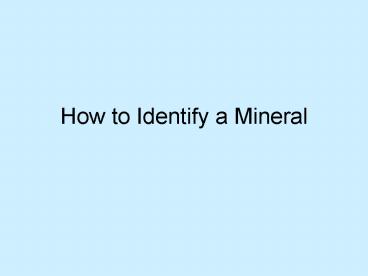How to Identify a Mineral - PowerPoint PPT Presentation
1 / 33
Title:
How to Identify a Mineral
Description:
How to Identify a Mineral Mineral Identification We identify minerals so we can recognize valuable resources (useful or beautiful). Mineral Identification There are 7 ... – PowerPoint PPT presentation
Number of Views:257
Avg rating:3.0/5.0
Title: How to Identify a Mineral
1
How to Identify a Mineral
2
Mineral Identification
- We identify minerals so we can recognize valuable
resources (useful or beautiful).
3
Mineral Identification
- There are 7 tests performed on minerals so they
can be identified.
4
Test 1
5
Test 1
- Mineral Appearance Color and appearance are two
clues used to identify minerals.
Azurite can always be identified by its striking
blue color.
6
Test 1
- However, this test is not enough to identify most
minerals.
Which one is gold and which one is iron pyrite
(fools gold)?
7
Test 2
8
Test 2
- Hardness the measure of how easily a mineral can
be scratched.
Talc can be scratched by a fingernail, diamonds
cannot be scratched by anything but another
diamond.
9
http//www.cnn.com/2012/08/09/living/olympians-bit
e-medals/index.html
10
Test 2
- Hardness is measured using a Mohs scale.
11
Test 3
12
Test 3
- Luster the way a mineral reflects light.
13
Test 3
- A mineral can be metallic or non-metallic, such
as glassy, dull, pearly, or silky.
Non-metallic, dull
Metallic
Non-metallic, glassy
14
Test 4
15
Test 4
- Specific Gravity a minerals weight is compared
to the weight of an equal sized amount (volume)
of water.
Gold has a specific gravity of 19, iron pyrite is
5 ( 5 times heavier than water.)
16
Fake or real???
17
Test 5
18
Test 5
- Streak the color a mineral leaves on a porcelain
tile.
Hematite (on left) looks gray, but leaves a
reddish-brown streak. Iron pyrite (on right) is
gold colored, but leaves a greenish-black streak.
19
Test 6
20
Test 6
- Cleavage or Fracture how a mineral breaks.
21
Test 6
- Cleavage the physical property of some minerals
that allows them to break along smooth, flat
surfaces.
Mica always cleaves in thin, flat sheets. Halite
cleaves at 90 degree angles.
22
Test 6
- Fracture the physical property of some minerals
that causes them to break with uneven, rough, or
jagged surfaces.
23
Test 7
24
Test 7
- Other properties some minerals have unique
properties that allow them to be easily
identified.
Magnetite will pick up iron like a magnet
25
Test 7
Calcite can cause double images
26
Test 7
Willemite and Calcite have a property known as
fluorescence, they will glow under uv light
These minerals glow in the mining tunnel when
under uv light
27
Summary
- There are 7 tests to determine the identity of a
mineral - Color and appearance
- Hardness
- Luster
- Specific Gravity
- Streak
- Cleavage and Fracture
- Other Properties
http//www.youtube.com/watch?vc7wJP_K_sAQfeature
related
http//abcnews.go.com/US/oklahoma-teenager-finds-3
85-carat-canary-diamond/story?id20633996
28
Review
- What are the 7 tests?
Color and appearance Hardness Luster Specific
Gravity Streak Cleavage and Fracture Other
Properties
29
Review
- Why do we sometimes need to do more than one
test? - It may be difficult to identify a mineral based
on only one characteristic. It may share common
features with other minerals.
30
Review
- Which test uses the Mohs scale?
- Hardness
31
Review
- What type of luster do each of the following
minerals have? (Metallic or Non-metallic) - Metallic, non-metallic, non-metallic, metallic
32
Review
- What type of breakage do these minerals show?
- Cleavage, fracture, fracture
33
Review
- 6. Which test is being performed here?
- Streak Test































